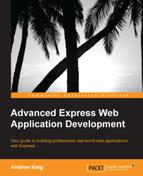With the foundations in place, we begin the process of building a Web API for our Vision project. We will start by setting up a persistence layer using MongoDB. We will then implement, feature-by-feature, the various aspects of our Web API.
MongoDB is an open source document-oriented database system. MongoDB stores structured data such as JSON-like documents, simplifying integration.
Let's start by creating a MongoDB schema for our project. The schema contains some basic information related to the project such as the project's name, a GitHub access token, a user, and a list of repositories.
Let's install Mongoose, a MongoDB Object Document Mapper for Node.js; it provides a schema-based solution to modeling your data.
npm install mongoose --save
Let's configure our application to use MongoDB and Mongoose; we add a URL for MongoDB to our configuration files ./lib/config/*.js:
{
"express": {
"port": 3000
},
"logger" : {
"filename": "logs/run.log",
"level": "silly"
},
"mongo": {
"url": "mongodb://localhost/vision"
}
}Let's create a MongoDB connection module, ./lib/db/index.js, which simply pulls in the MongoDB URL from our Winston configuration and opens a connection:
var mongoose = require('mongoose')
, config = require('../configuration')
, connectionString = config.get("mongo:url")
, options = { server: { auto_reconnect: true, poolSize: 10 } };
mongoose.connection.open(connectionString, options);We now create a model class ./lib/models/index.js that defines our ProjectSchema:
var mongoose = require('mongoose'),
Schema = mongoose.Schema;
var ProjectSchema = new Schema({
name : { type: String, required: true, index: true }
, token : { type: String }
, user : { type: String, required: true, index: true }
, created : { type: Date, default: Date.now }
, repositories : [ { type: String } ]
});
mongoose.model('Project', ProjectSchema);
module.exports = mongoose;In order to run the following examples, we need a running instance of MongoDB. You can download MongoDB from http://www.mongodb.org. Run the following command to start MongoDB:
mongod
